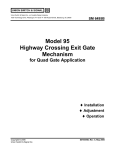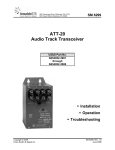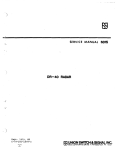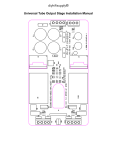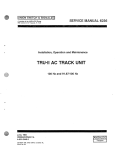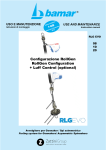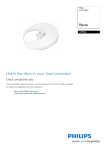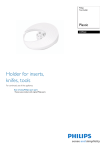Download High Frequency Track Circuits
Transcript
645 Russell St. Batesburg, SC 29006 Service Manual 5865 High Frequency Track Circuits Installation and Maintenance December, 1999 © 1999, Union Switch & Signal Inc. Printed in USA An ANSALDO Signal Company Revision Index Date of Revision August, 1980 December, 1999 SM5865 (12/99) i Table of Contents SECTION 1.0 1.1 1.2 2.0 2.1 3.0 3.1 3.2 3.3 3.3.1 3.3.2 3.3.3 4.0 TOPIC PAGE GENERAL INFORMATION ......................................................................... 1-1 INTRODUCTION ......................................................................................... 1-1 R.A.I.L. TEAM AND TECHNICAL SUPPORT.............................................. 1-2 OPERATION..................................................................................................... 2-1 High Frequency Track Circuit Function ............................................................. 2-1 DESCRIPTION ................................................................................................. 3-1 Transmitter........................................................................................................ 3-1 Receiver............................................................................................................ 3-1 Associated Hardware ........................................................................................ 3-2 Track Connections and Rail Bonds................................................................... 3-2 Receiver Relay.................................................................................................. 3-2 Lightning Protection .......................................................................................... 3-2 APPLICATION AND INSTALLATION DATA ................................................... 4-1 4.1 Frequency Selection ......................................................................................... 4-1 4.2 Track Circuit Connection Arrangements ........................................................... 4-1 4.2.1 General Information .......................................................................................... 4-1 4.2.2 Typical Track Circuit Illustrations ...................................................................... 4-1 4.3 Equipment Mounting Data................................................................................. 4-5 4.4 Tuning Sensitivity Adjustments ......................................................................... 4-6 5.0 FIELD INSPECTION AND SERVICING ........................................................... 5-1 5.1 Test Equipment and Periodic Inspection........................................................... 5-1 5.1.1 Transmitter........................................................................................................ 5-1 5.1.2 Receiver............................................................................................................ 5-1 5.2 Field Servicing .................................................................................................. 5-2 APPENDIX PARTS LIST........................................................................................A-1 A.1 Transmitter and Receiver Assemblies ......................................................... A-1 A.2 Circuit Boards .............................................................................................. A-1 A.3 General Parts List........................................................................................ A-2 A.4 Auxiliary Tabulation ..................................................................................... A-4 SM5865 (12/99) i Table of Contents LIST OF FIGURES 1-1 1-2 3-1 4-1 4-2 4-3 4-4 4-5A 4-5B 4-6 4-7 4-8 A-1 A-2 A-3A A-3B A-4A A-4B Physical Layout ........................................................................................... 1-1 Electrical Layout .......................................................................................... 1-1 Diagonal Shunt Installation .......................................................................... 3-3 Single Track Circuit ..................................................................................... 4-2 Dual Circuit with Diagonal Shunt ................................................................. 4-2 Single Switch Track Circuit .......................................................................... 4-3 LAP Switch Track Circuit ............................................................................. 4-3 Short Circuits ............................................................................................... 4-4 Short Circuits ............................................................................................... 4-4 Overlapped Circuits ..................................................................................... 4-5 Mounting Equipment.................................................................................... 4-5 Rail-to-Rail Shunt Connection ..................................................................... 4-8 Wiring Diagram for High Frequency Track Circuits...................................... A-4 Assembly of Equipment for High Frequency Track Circuits ......................... A-5 Transmitter Circuit Diagram and Parts Reference ....................................... A-6 Transmitter Circuit Diagram and Parts Reference ....................................... A-7 Receiver Circuit Diagram and Parts Reference ........................................... A-8 Receiver Circuit Diagram and Parts Reference ........................................... A-9 LIST OF TABLES 4-1 5-1 5-2 ii Standard Values for Tuning Circuits ............................................................ 4-7 Transmitter Field Servicing .......................................................................... 5-2 Receiver Field Servicing .............................................................................. 5-3 SM5865 (12/99) Section 1.0 – INTRODUCTION 1.1 GENERAL INFORMATION The US&S High Frequency Track Circuit is designed to be used where short track circuits are required, such as in classification yards, to provide switch locking protection. Insulated joints are not necessary with this circuit. The equipment is completely transistorized and is designed to operate from 117 volt, 60 Hz power source. Since the track circuits are short, the condition of the ballast is not critical. More important is the ability to work in areas where there is rail film, such as normally found in classification yards. Tests with the high frequency circuits have shown no indication of failure to shunt when a heavy grease film mixed with dirt was applied to the rails. Track circuits have been employed with lengths of between 60 and 250 feet, and no difficulty is foreseen in lengths up to 300 feet. A typical high frequency track circuit consists of a transmitter, receiver and associated relay, connected between two (2) rail-to-rail shorts, which define the limits of the track circuit. The transmitter is connected approximately twenty (20) feet from one short with capacitors connected within the unit and on the output terminals to tune that section of the track to the transmitter frequency. The receiver is connected approximately twenty (20) feet from the other short with capacitors connected within the unit and on the input terminals to tune that section of the track to the transmitted frequency. Electrically, this makes the enclosed section of track look like two tuned circuits coupled in parallel with the inductance of the untuned section of track in series. (See Figures 1-1 and 1-2.) FIGURE 1-1. PHYSICAL LAYOUT FIGURE 1-2. ELECTRICAL EQUIVALENT SM5865 (12/99) 1-1 Section 1.0 - INTRODUCTION The equipment is contained within a weatherproof case that is pedestal mounted on the wayside at 3 feet from the nearest rail. Power input, track, and relay output connections are made to an AAR terminal strip mounted internally. The receiver relay is external and can be located where convenient, up to several thousand feet away from the receiver. 1.2 R.A.I.L. TEAM AND TECHNICAL SUPPORT The Rapid Action Information Link (R.A.I.L.) Team is comprised of a group of experienced product and application engineers ready to assist and resolve any technical issues concerning any US&S product. Any questions regarding the contents of this Service Manual can be answered by contacting the R.A.I.L. Team toll free at 800-652-7276 or via e-mail: [email protected]. 1-2 SM5865 (12/99) Section 2.0 - OPERATION 2.1 High Frequency Track Circuit Function The High Frequency Track Circuit functions by applying bursts of high frequency energy into the tuned section of track from the transistor oscillator and power amplifier that form the transmitter. The energy is coupled through the rails into the tuned section of track at the receiver input. These bursts of energy are of approximately two-millisecond duration, with approximately eight-milliseconds between bursts. The input circuit of the receiver transformer couples this energy into a bridge rectifier, which converts the high frequency energy into square pulses of two-millisecond duration with eight-milliseconds between pulses. When these pulses are of sufficient amplitude to trigger the fail-safe peak detector, a separate frequency of approximately 220 kHz is generated in the receiver. This signal is amplified, detected and converted into a D-C control voltage to energize the relay. As long as the amplitude of the input triggers the peak detector, the relay will be held energized. The relay will drop out from failure of input power to either the receiver or transmitter, from loss of connections to the rails or from normal shunting of the track by a car. This will de-tune and short either the output of the transmitter or input to the receiver, or both, depending on the position of the wheels within the limits of the track circuit. Because of the rail-to-rail shorts, which define the limits of the track circuit, it is virtually impossible to get interference from adjacent circuits. Also, the receiver input is very selective with its high “Q” parallel resonant input circuit; and a transmitter of another frequency can be operated directly across the receiver inputs without causing false operation. SM5865 (12/99) 2-1 Section 2.0 - OPERATION This page is intentionally blank. 2-2 SM5865 (12/99) Section 3.0 - DESCRIPTION 3.1. Transmitter The transmitter consists of: a printed circuit board containing a rectifier to convert the power supply to DC; an RF oscillator; a timing multivibrator, which controls the transmitter ON-OFF duty cycle; a single-ended Class “B” power amplifier; a power transformer, which converts the 117 volts, 60 Hz supply voltage to 32 volts; and a separate board with solder terminals for mounting capacitors to tune the track. An AAR terminal strip provides for external connections to the track, the supply voltage and the case ground. Provisions are included for mounting lightning arresters in installations where they are required. A complete unit can be furnished with or without arresters. All of this is contained in a weatherproof box that is mounted near the rails, so that the track lead to the nearest rail is no longer than three feet. The supply voltage leads enter the box through the bottom, while the track leads enter through a weatherproof fitting on the end nearest the rails. The transmitter output amplifier is capable of driving a minimum ballast impedance of 2 ohms/1000 ft. The timing and “Q” of the track will determine the load impedance seen by the transmitter with very little effect from the ballast since the track circuit is short. Typical load impedance of twelve ohms would permit peak output power during the pulse of approximately fifty watts. The efficiency of the circuit is very high due to Class “B” operation and low duty cycle. The available frequencies for operation are 46.5 kHz, 57 kHz, 71. 5 kHz, and 89 kHz. 3.2 Receiver The receiver consists of: a printed circuit board containing all the circuitry necessary to convert the R.F. signal received from the track to a DC voltage (to operate a 400 ohm relay); a power transformer (to change the 117 volts, 60 Hz supply voltage to 25. 2 volts, 60 Hz); and a separate board with solder terminals for mounting capacitors to tune the track. An AAR terminal strip provides for external connections to the track, supply voltage and relay. Provisions are included for mounting lightning arresters in installations where they are needed. All of this is contained in a weatherproof box, which is mounted near the rails so that the track lead to the nearest rail is no longer than three (3) feet. The supply voltage and relay leads will enter the box through the bottom, while the track leads will be brought through a weatherproof fitting on the end towards the rails. SM5865 (12/99) 3-1 Section 3.0 - DESCRIPTION 3.3 ASSOCIATED HARDWARE 3.3.1 Track Connections and Rail Bonds The track connections, rail bonds, and rail-to-rail shorts must be very securely fastened and properly located or the track circuit cannot function properly. Any loosening, breaking or shifting of connections can change the tuning or completely disable the system. All track leads should be AWG #6, insulated, stranded wire, or equivalent insulated bond wire. These leads should be twisted at least three twists per foot between the nearest rail and the transmitter or receiver mounting box. The lead to the far rail must be as short as possible. The rail-to-rail shorts consist of two leads of the same wire as the track leads and spaced a minimum of five inches apart with staples driven into the ties. The ends must be securely bolted or welded to the web of the rails. All rail bonds must be heavy gauge, railhead-type, either welded or swaged securely into the rail for best operation. Longer bonds may be used where rail hardware makes it necessary, but the railhead-type is preferred and should be used whenever possible. In applications where two track circuits are in series and a sharp transfer from one circuit to the other is required, a diagonal shunt must be installed in a ten-foot section of track. This diagonal must be made of three leads equivalent to the track leads. These may be connected at one point on each rail, but the leads must be spaced a minimum of five inches apart and stapled to the ties between the rails. The receiver of one circuit is connected at one end of the diagonal shunt, and the receiver or transmitter of the other circuit is connected at the other end of the diagonal shunt (See Figure 3-1) for further information, refer to Section 4.0 Application and Installation Data. 3.3.2 Receiver Relay The receiver is designed to operate a relay with a 400-ohm coil, typically the PN-150B (N322500-001) or PN-50B (N292701). The pick-up voltage is normally 5.3 volts DC and the drop-away 1.9 volts DC. The current at 5.3 volts is only .0132 ampere; therefore, the relay can be located several thousand feet from the receiver and still be operational. 3.3.3 Lightning Protection Provision has been included for mounting a Style USG Arrester, N314265, from each track lead to ground in both the receiver and transmitter. Actual installation of the arresters is required when the particular track circuit is isolated from others or when it is the first or last of a number of track circuits along a section of track. 3-2 SM5865 (12/99) Section 3.0 - DESCRIPTION These arresters permit a maximum of 300 volts before breakdown. The pedestal that the equipment is mounted on provides grounding for the arresters. However, in areas where poor ground conductivity is experienced, conventional ground rods may be used with the arresters connected to the pedestal, the ground rod or both. FIGURE 3-1. DIAGONAL SHUNT INSTALLATION SM5865 (12/99) 3-3 Section 3.0 - DESCRIPTION This page is intentionally blank. 3-4 SM5865 (12/99) Section 4.0 - APPLICATION AND INSTALLATION 4.1. FREQUENCY SELECTION There are four frequencies available, 46.5, 57, 71.5 and 89 kHz. To assure that two track circuits operating on the same frequency do not interfere with each other, the following rules shall be observed. 1. Do not install track circuits directly parallel to each other on adjacent tracks unless the operating frequencies are different. Where there are three or more tracks in parallel, every other track may have the same frequency. 2. Do not install track circuits of the same frequency along the same track, unless a track circuit of a different frequency separates them. 3. Where two track circuits are to be installed with a diagonal rail-to-rail short between them to provide overlap of the two circuits, only the lowest and highest frequency available are to be used. This is presently 46.5 kHz for the lowest and 89 kHz for the highest. 4. In long track circuits, apply the lowest frequency available. 4.2 TRACK CIRCUIT CONNECTION ARRANGEMENTS 4.2.1 General Information The frequency allotted for each circuit shall be determined from the rules given in Section 4-1 Frequency Selection. Railhead bonds shall be used on all rail joints; and all other joints shall be bonded as short as possible, depending on track hardware conditions. 4.2.2 Typical Track Circuit Illustrations The following illustrated track circuit arrangements, shown in Figures 4-1 through 4-6 are given as examples that should provide sufficient information for proper installation of these track connections, as well as any not specifically given. The letters shown in parenthesis on each illustration indicate the applicable note from the following list. (a) Rail-to-rail short. Consists of two AWG #6 stranded copper insulated wire or equivalent, separated a minimum of five inches. The wire is stapled to the tie and securely attached to the web of the rail, either at a common point connection or at two separate points, while maintaining the five-inch separation. (b) Track leads. The leads to the transmitter and receiver must be twisted three twists per foot from the nearest rail to the unit housing, and the distance to the nearest rail must be three feet or less. SM5865 (12/99) 4-1 Section 4.0 - APPLICATION AND INSTALLATION (c) Where presence detectors are used, the detector “loop” must be located between the transmitter and receiver rail connections as shown. Under no circumstances may part of the “loop” be within a tuned section. (d) The diagonal shunt (see Figure 3-1). (e) Switch bonding. Bonding is necessary around heel blocks and between rails behind the heel block. (f) Switch rail-to-rail shorts. The rail-to-rail shorts must be between the “frog” and rail connections of transmitter or receiver. (g) Switch track leads. The rail connections for transmitter or receiver shall be made to the fixed rail. (h) Shunt zone. Maximum variation of shunting point will fall between the limits shown. FIGURE 4-1. SINGLE TRACK CIRCUIT FIGURE 4-2. DUAL CIRCUIT WITH DIAGONAL SHUNT 4-2 SM5865 (12/99) Section 4.0 - APPLICATION AND INSTALLATION FIGURE 4-3. SINGLE SWITCH TRACK CIRCUIT FIGURE 4-4. LAP SWITCH TRACK CIRCUIT SM5865 (12/99) 4-3 Section 4.0 - APPLICATION AND INSTALLATION FIGURE 4-5A. SHORT CIRCUITS FIGURE 4-5B. SHORT CIRCUITS Where space requirements necessitate, such as close-coupled switches (shown dotted), two circuits may be “overlapped” as shown. Each circuit will shunt independently. A1 need not equal A2, although all dimensions are subject to the length limitations as shown in Figure 4-5A. The transmitters can be staggered, if required, as shown in Figure 4-5B. 4-4 SM5865 (12/99) Section 4.0 - APPLICATION AND INSTALLATION FIGURE 4-6. OVERLAPPED CIRCUITS 4.3 EQUIPMENT MOUNTING DATA A transmitter or receiver basic housing consists of a cast iron box, M374986, with cover M347723, and a pedestal, M224650, which are shipped separately. The unit is mounted near the rails with the pedestal buried in the ground, so that the bottom of the box is two to four inches above the ground. The length of the track lead to the nearest rail shall be no longer than three feet (see Figure 4-7). The 117 volt, 60 Hz power lead and the relay control wires are brought through a special opening in the pedestal and through the bottom of the box. The track leads are brought through the end of the box nearest the rails. The terminals on the AAR terminal strip are identified for convenience in wiring all external connections. A second soldertype terminal strip is provided to mount the tuning capacitors required to resonate that section of track between the track lead connections and the rail-to-rail short. FIGURE 4-7. MOUNTING EQUIPMENT SM5865 (12/99) 4-5 Section 4.0 - APPLICATION AND INSTALLATION 4.4 TUNING AND SENSITIVITY ADJUSTMENTS Proper tuning of the track is most easily accomplished by using an oscilloscope and a decade capacitor box. A fixed capacitor has been installed on the track lead terminal strip. Additional capacitors must be installed during installation to fine-tune the track. These capacitors will be in parallel with the fixed capacitor. Before any AC power is connected to the transmitter, connect a decade capacity box to the track lead and set it to 1 MFD to tune the track. Then turn on the power and reduce the decade box setting until a maximum signal is obtained across the terminal as discussed below. After tuning, fixed capacitors equal to the final setting of the decade box are then installed. The range of capacitance required to tune a track circuit will vary from approximately .33 MFD for the highest frequency to approximately 2.0 MFD for the lowest frequency, depending on the installation arrangement. In most cases, the track circuit will be short enough that it will be best to tune the transmitter and receiver simultaneously, or at least back and forth, until the maximum signal is obtained. To tune the transmitter, it is best to connect an oscilloscope at the rail connections and the decade box at the track connections inside the transmitter enclosure. To tune the receiver, it is best to connect both the oscilloscope and decade box at the track connections inside the receiver enclosure. Temporarily connect a non-inductive 10-ohm, 50-watt resistor in series with one lead of the transmitter. Adjust the decade capacitor boxes in equal steps at both the transmitter and receiver until resonance is obtained in both circuits. This is indicated by obtaining a maximum signal on the scope. Note The capacitance at the receiver and transmitter may differ 10 to 20 percent at resonance in a straight track circuit, and nearly 100 percent when one is on straight track and the other at a diagonal shunt. Remove the resistor and recheck the tuning before proceeding. The amplitude of the signal at the transmitter may be between 50 and 80 volts peak-topeak, while at the receiver it may be between 50 and 150 volts peak-to-peak. When the capacitance value has been determined, remove the decade box, and solder fixed capacitors to the terminal board provided in each enclosure, equal to the decade setting. In every case, choose capacitors that are equal to or slightly less than the decade setting, never larger. 4-6 SM5865 (12/99) Section 4.0 - APPLICATION AND INSTALLATION The following standard values should provide enough combinations to satisfactorily tune all circuits. TABLE 4-1 STANDARD VALUES FOR TUNING CIRCUITS .015 MFD ±10% 200 volt J709144-0076 .047 MFD ±10% 200 volt J709144-0075 .10 MFD ±10% 200 volt J709144-0083 .15 MFD ±10% 200 volt J709144-0082 .33 MFD ±10% 200 volt J709144-0081 .47 MFD ±10% 200 volt J709144-0080 .56 MFD ±10% 200 volt J709144-0079 .68 MFD ±10% 200 volt J709144-0078 ±10% 200 volt J709144-0077 1.0 MFD NOTES 1. On track circuits longer than 100’, tuning should be done by first shorting the receiver track terminals and then adjusting the transmitter decade box for maximum signal. Finally remove the short from the receiver and tune the receiver end. 2. For diagonal shunt arrangements with two circuits adjacent to each other, tune the low frequency unit first with the high frequency circuit open circuited, with the low frequency circuit intact and tuned. After the tuning capacitors have been installed, proceed with the sensitivity adjustment as follows: (a) Connect an oscilloscope across the receiver input terminal. (b) Connect a DC voltmeter (set on the 10-volt range) across the relay terminals. (A 400-ohm relay or resistor should be connected to the terminals for proper loading.) (c) Connect a rail-to-rail shunt on the rail midway between the receiver track connections and the receiver rail-to-rail short. The rail-to-rail shunt wire should be at least #6 AWG and not longer than seven feet. See Figure 4.8. SM5865 (12/99) 4-7 Section 4.0 - APPLICATION AND INSTALLATION FIGURE 4.8 RAIL-TO-RAIL SHUNT CONNECTION Note: The location of the shunt in the center of the shunt zone as shown in Figure 4.8 will satisfy most applications. However, in congested areas where there is an abundance of steel traversing between the rails in the shunt zone, a shift of four or five feet of the shunt location closer to the receiver might be necessary to properly adjust the track circuit. (d) Set the sensitivity control on the receiver for a reading of 1.9 ± .1 volt DC on the multimeter. (e) Loosen the south end of the rail-to-rail shunt and connect to point “a.” Verify that the voltage level increases. (f) Move the south end of the rail-to-rail shunt from point “a” to point “b.” Verify that the voltage level decreases. (g) Remove the shunt. The voltage should rise to 5.8 ± .3 volts DC. The circuit is now ready for operation. 4-8 SM5865 (12/99) Section 5.0 - FIELD INSPECTION AND SERVICING Regularly scheduled maintenance for any type of equipment is the best way to assure reliable operation for a long period of time. Therefore, the following information is given to assist in establishing some form of periodic inspection and test. 5.1 TEST EQUIPMENT AND PERIODIC INSPECTION For a quick simple check of the equipment’s general condition, all that is needed is an analyzer similar to a Simpson Model 260. The periodic test should consist of the following checks: 5.1.1 Transmitter Visibly inspect for moisture damage and component discoloration from overheating. Refer to Figure A-3 for transmitter circuit and parts reference. Note the following voltages: (a) Line voltage, 117 volts ± 10%, 60 Hz. (b) Power input to board, 32 volts ± 10% 60 Hz. (c) DC across C8, 40 volts ± 10% (d) DC across C1, 26 volts ± 10% *(e) Output, 2.5 volts RMS minimum * This low voltage reading is the result of a 20% duty cycle, pulse operation. Continuous operation of the transmitter output would give a reading approximately five times as high. 5.1.2 RECEIVER Visibly inspect for moisture damage and component discoloration from overheating. Refer to Figure A-4 for receiver circuit and parts reference. (a) Line voltage, 117 volts ± 10%, 60 Hz. (b) Power input to board, 25.2 volts ± 10% 60 Hz. (c) DC across C16, 36 volts ± 10%. (d) Relay voltage, 5.8 volts DC, ± .3 volts. *(e) Input from track, 2.5 volts minimum. * This is the RMS reading of the 20% duty cycle of the transmitted pulse. If the reading is between 12 and 20 volts RMS, the transmitter is in continuous transmission instead of pulse. SM5865 (12/99) 5-1 Section 5.0 - FIELD INSPECTION AND SERVICING The historical record of several inspections provides a means of determining when a unit is about to fail, because a consistently repeated reading establishes the proper operating reference. Therefore, when a particular reading begins to change from one inspection to another, this can be interpreted as an approaching failure in that unit. 5.2 FIELD SERVICING In the event that actual failure occurs, the voltage checks of the periodic inspection will provide enough information to determine where the failure has occurred. Interpretation of readings is shown on the following troubleshooting tables. TABLE 5-1. TRANSMITTER FIELD SERVICING INDICATION CORRECTIVE ACTION 1. No line voltage Check power distribution system and cabling. 2. Low line voltage when circuit is connected. Check transformer for shorted turns, or shorts on the printed circuit board. Replace transformer or printed circuit board. 3. Low DC voltages. (a) Check tracks and track leads for shorts. (b) Check to see that tuning capacitors are not broken loose or defective. (Detuned circuit loads DC supply) (c) Replace printed circuit board if (a) and (b) are good. 4. Low output. Same as step three (3). 5. High output. Replace printed circuit board as timing multivibrator circuit is defective, allowing transmitter to operate continuously. 5-2 SM5865 (12/99) Section 4.0 - APPLICATION AND INSTALLATION TABLE 5-2. RECEIVER FIELD SERVICING INDICATION CORRECTIVE ACTION 1. No line voltage Check power distribution system and cabling. 2. Low line voltage when circuit is connected. Check transformer for shorted turns or shorts on the printed circuit board. Replace defective part. 3. Low DC voltage If line voltage is good, check for a short circuit in output to relay or low relay voltage. Replace board. 4. No relay voltage Check for signal on input terminals. If input from track is low or too high, trouble is in track or transmitter. NOTE If input RMS voltage is greater than 12 V RMS, the transmitter is operating continuously and the receiver cannot respond to a continuous input. 5. No input SM5865 (12/99) Check all track leads and rail connections for opens or shorts. Check transmitter output. Repair track leads or replace transmitter as required. 5-3 Section 5.0 - FIELD INSPECTION AND SERVICING This page is intentionally blank. 5-4 SM5865 (12/99) Appendix A – PARTS LIST The parts list that follows is a tabulation of the parts that may be necessary to maintain this equipment. These parts may be ordered directly from Union Switch & Signal Inc. A.1 Transmitter and Receiver Assemblies Part No. Complete Description Part No. less Pedestal Transmitter Assembly, with Arrestor 46.5 57 71.5 89 kHz kHz kHz kHz Transmitter Transmitter Transmitter Transmitter * * * * X451147-0135 X451147-0139 X451147-0143 X451147-0147 N451147-0103 N451147-0107 N451147-0111 N451147-0115 X451147-0133 X451147-0137 X451147-0141 X451147-0145 N451147-0101 N451147-0105 N451147-0109 N451147-0113 Receiver Assembly, with Arrestor 46.5 57 71.5 89 kHz kHz kHz kHz Receiver Receiver Receiver Receiver * * * * A.2 Circuit Boards Circuit Boards for Transmitters 46.5 57 71.5 89 kHz kHz kHz kHz Transmitter Transmitter Transmitter Transmitter N451055-1201 N451055-1202 N451055-1203 N451055-1204 Circuit Boards for Receivers 46.5 57 71.5 89 kHz kHz kHz kHz Receiver Receiver Receiver Receiver N451055-1301 N451055-1302 N451055-1303 N451055-1304 * Complete Assemblies include Pedestal SM5865 (12/99) A-1 Appendix A – PARTS LIST A.3 General Parts List Item # 5 10 15 20 25 30 35 40 45 50 55 60 65 70 75 80 85 90 95 100 105 110 115 120 125 130 135 140 145 150 155 160 165 170 175 180 185 190 195 200 205 A-2 Description Box Cover Elbow, 1st St M I Galv Gsk Nprn Spg ½ x ½ Not used SC 3/8 x 1-¼ Set Cad P Nut, 3/8 Hex Stl Cad P Plate, Mounting SC ¼ - 20 x 7/8 Fil Stp Washer, ¼ M LK S TP Block, Terminal, 7 way Block, Terminal 3 way Washer Nut Nut Arrester Connector, Term Chassis Transformer Board, Pri-Cir Board, Term Spacer Nut-6-31 Hex Stl Tr Bushing 2 ½ x 2 Red Bushing, 2 x 1 ¼ Red Nut, Lock Plastic Cap Plug Plastic Cap Plug Elbow, 1 ¼ St M I Galv Pipe, 1 ¼ Galv Nut, ¼ - 20 Hex Stl Tp SC 4-40x 5/16 bind Stl Tp Washer 4 M Lk S Tp Washer, 4 Plate S Tp SC 8-32 x ½ Bind Stl Tp Washer 8 M Lk S Tp Washer 8 plate S Tp Spacer SC 8-23 x 3/8 Bind Stl Tp SC 2 x ¼ Rd Type U Drive Sc Tp Nut 8-32 Hex Stl Tp Part No. M374986 M347723 J32485 A690937 Not used J50577 J48009 M451148-0101 J52202 J47775 M225586 M109154 J47818 M29103 M29101 N451552-0101 M47290 See Aux Tab See Aux Tab See Aux Tab J776611 J772336 J048148 J032088 J32054 M373656 J703517 J703516 J32486 M437182 J48002 J50996 J47765 J47640 J50992 J47681 J47745 M485696 J507235 J52648 J48166 SM5865 (12/99) Appendix A– PARTS LIST Item # 210 215 220 225 230 235 240 245 250 255 260 265 270 275 280 285 290 300 305 310 315 320 325 330 335 340 345 350 355 360 365 370 SM5865 (12/99) Description Plate, Name Receptacle, DX SC 6-32 x 3/8 Pan Stp Pipe, 1” Galv Screen Bushing, 1” Conduit Bolt, ½ - 13 x 3-1/2 Hex Nut, ½ Hex X Jam Cad P Nut, ½ Hex Stl Cap P. Washer ½ Plat Stl Cad P Washer # 6 Lock Stl Tag, B x 110 Tag, N x 110 Rag, Relay + Tag, Relay Tag, Track 1 Tag, Gnd Term, #6 Amp Term. #12 – ¼ amp Wire #18 Flex (Bk) Wire, #18, Flex (W) Grommet Scr. ¼ - 20 x 358 Pnh Stl Nut, Insulated SC 4-40 x ¼ Flat Stl Tp Tag, Track E Term # 10 Amr Initial Tuning Cap Wire, #20 Bare Copper Wire, #20, PVC Grn M-258-30 Tubing Wshr – 10 Flt Stl Part No. M451425-9701 J72030 J507262 M26503 M435695 J69677 J046563 J48016 J48013 J47503 J047662 J75510-0689 J75510-0080 J75510-1157 J75510-1158 J75510-1169 J75510-0566 J730239 J730041 A45665-0000 A45665-0009 J751238 J507263 J48300 J521070 J75510-1170 J730048 See Tab A043180 A045505-0004 A774201 J475077 A-3 Appendix A – PARTS LIST N451147 Circuit Bd Transformer F451055 SH C8605 Initial Tuning Capacitor Mfd Freq kHz Group Chassis Suffix RCVR or XMTR Housing A.4 Auxiliary Tabulation SH -0101 -0117 1 46.5 N451055-1301 13 J730805 -- J709144-0178 0.68 -0103 -0119 3 46.5 N451055-1201 12 N435551 68 J709144-0078 0.68 -0105 -0121 1 57 N451055-1302 13 J730805 -- J709144-0078 0.60 -0107 -0123 3 57 N451055-1202 12 N435551 68 J709144-0078 0.68 -0109 -0188 1 71.5 N451055-1303 13 J730805 -- J709144-0081 0.33 -0111 -0127 3 71.5 N451055-1203 12 N435551 68 J709144-0081 0.33 -0113 -0189 1 89 N451055-1304 13 J730805 -- J709144-0082 0.15 -0015 -0131 3 89 N451055-1204 12 N435551 68 J709144-0082 0.15 FIGURE A-1. W IRING DIAGRAM FOR HIGH FREQUENCY TRACK CIRCUITS A-4 SM5865 (12/99) Appendix A– PARTS LIST FIGURE A-2. ASSEMBLY OF EQUIPMENT FOR HIGH FREQUENCY TRACK CIRCUITS SM5865 (12/99) A-5 Appendix A – PARTS LIST FIGURE A-3A. TRANSMITTER CIRCUIT DIAGRAM AND PARTS REFERENCE A-6 SM5865 (12/99) Appendix A– PARTS LIST FIGURE A-3B. TRANSMITTER CIRCUIT DIAGRAM AND PARTS REFERENCE SM5865 (12/99) A-7 Appendix A – PARTS LIST FIGURE A-4A. RECEIVER CIRCUIT DIAGRAM AND PARTS REFERENCE A-8 SM5865 (12/99) Appendix A– PARTS LIST FIGURE A-4B. RECEIVER CIRCUIT DIAGRAM AND PARTS REFERENCE SM5865 (12/99) A-9 Appendix A – PARTS LIST This page is intentionally blank. A-10 SM5865 (12/99)



































